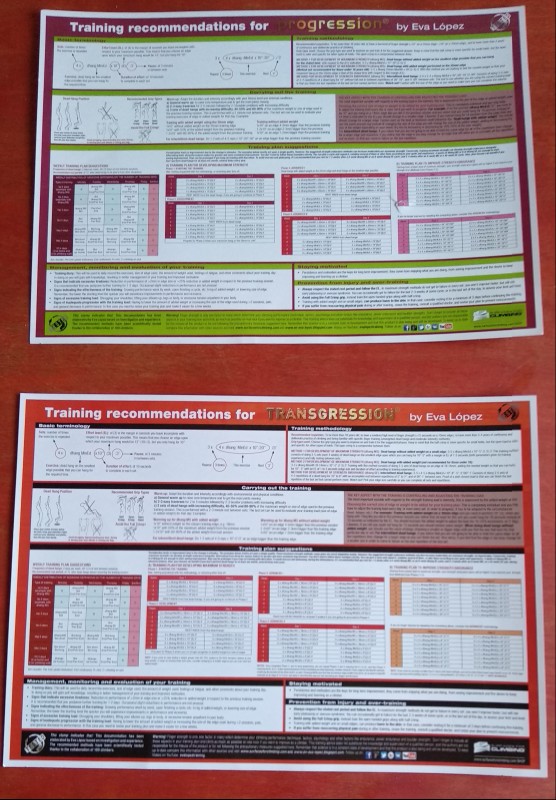Versión en español
After this long and verbose chain of entries, now it's time to wrap up the series by putting forward some exercises that attend to each particular objective. But first we will go over some previously presented statements that will serve as a kind of preface:
Conclusions about Lock-offs in Climbing
- A specific strength exercise is one that reproduces the mechanical pattern (joint angles, speed of movement), duration of force application and kind of exercise regimen (concentric, isometric, eccentric), along the same muscle groups (or parts of them), that is typical of the gesture that we want to increase performance on. An additional characteristic is that they can also be facilitated or the opposite, like when we use elastic bands or added weight (Wilson et col., 1996; González-Badillo and Ribas, 2002; González-Badillo and Izquierdo, 2008).
- Regarding the usual duration of a lock-off, and focusing on technically proficient climbers, most of the time it is so short that it's even hard to appreciate it. The static phase of every move is the one where the elbow is no longer flexing and we start to let go of the hold with the other hand; a very brief moment that, as we already saw, lasts for 0,15 to 0,30seconds. From these figures we can deduce an important practical aspect:
This phase is so short that there are circumstances, specially for boulderers, or when grabbing small holds on steep overhangs, or that when a move requires a lot of precision, where there actually is not enough time for us to apply all the force that we are capable of. In these cases -and here we are just talking physical factors- what comes into play is what we can call explosive lock-off strength.- In other situations a lock-off can last longer (from 0,5 to 1 second) and condition the performance in certain circumstances such as roofs, crossing hands, transitioning from roof to vertical, clipping, or long moves on a slab. They are also more frequent when onsighting or bouldering than when working a lead route.
- The more typical, and as such, specific joint angles are 90-100º and 45-60º.
- Performing either a high intensity or a prolonged lock-off (like the lock-offs to fatigue method) is very stressing for the elbow anddangerous. The reason is that in a tiny area a lot of structures come together: bicipital aponeurosis, ulnar collateral ligament, ulnar nerve, pronator teres, finger and wrist flexor muscles... so that this region is prone to suffer from compression (neuropathies). In addition, each of them is disproportionately small for the load that it has to bear, making it prone to microtraumas and overload (epicondylalgia and tendinopathies) when the intensity is excessive or the workout volume is suddenly increased. As someone who knows a thing or two about the elbow says, they are not at all prepared for the effort we subject them to while climbing
- So, if we ever feel we have to train lock-offs, it should be only after a long enough adaptation phase, so that the structures are better prepared to sustain the punishment of climbing; this includes hypertrophy, and changes in composition, visco-elastic properties and stiffness, metabolic changes, etc. The scale here is in years of constant and progressive activity (perhaps as long as 5), not in months.
Who can train lock-offs and when?
It goes without saying that beginners must NOT work this quality, not even those with an intermediate level. As that point it is better to focus on the development of a rich perceptive-motor repertory as the main physical work. In my opinion, there are JUST SOME cases, regarding particular goals, that justify training them, and this assuming an already advanced level. Even then, not the whole season long, and carefully picking the methodology:
- If you have ample (5+ years) of climbing experience, and an already high technical-tactical development that allows you to solve most sequences in a more efficient, not-so-static fashion
- If you have extensive (3+ years) upper body strength training experience, and are familiar with the pull-up gesture, strong enough and well-balanced shoulders, and high pulling force (15-20 pull-ups, and 5 or more with 10-15 kg added weight);
- If you aren't fully recovered from a previous weakness or injury in your elbows (at least 2-6 months of progressive rehab). NOTE: if the day after training lock-offs you notice elbow or shoulder pain, stop that training and take immediate measures no matter what;
- So, if after all the information you still deem beneficial to train this muscle action in some of its variants because it is a limiting factor for you; and you find a method that will not harm your technique or your tactics (see this previous entry); then, depending on your objective, you could perform 1-2 sessions a week for 4-8 weeks, resting 24-72 h between sessions and making sure you feel well-rested, always at the beginning of the workout and after a good warm-up, of some of the following proposed exercises:
Objective: Maximum Strength Lock-off
This would be the case where you feel limited in many of your climbs by your capacity -once the most efficient method is found- to hold a high percentage of your body mass, or to hold a position with just one arm for longer than usual.
1- Maximum lock-off: Suitable for climbers who can lock-off with one arm for more than 2 seconds and less than 5. Those who can hold longer could skip to the explosive methods described later. The methodology is as follows:
- 2-5 sets of 1-2 seconds with complete recuperation (3+ minutes); 4-week cycles at most (ex.: 1st week 2 sets, 2nd week 3 sets...). Then we either stop it or rest for some weeks and start again changing some parameter (like number of sets or duration of effort) or, better yet, doing a different exercise for 4-8 weeks with a reduced load.
- The load will be such that we avoid muscle failure, using added weight or facilitating (rubber bands) as needed. Don't worry, your gains won't be smaller this way, an you will reduce your risk of injury. We can use the concept of Effort Level (EL), that is the margin in seconds that we leave before muscle failure for a given load. For lock-offs we could use an EL of 1-4. We will choose the load like this: if we have to do 1-second sets with an EL(3), we will use a stronger aid or by the contrary add some weights so that we could hold the lock-off for 1-3=4 seconds, but we will only do 1 second, leaving that 3-second margin.
- Depending on our level we can do it one-handed or with both arms.
- Better to use a bar or a really good hold, preferably with our palm(s) facing us.

2-A facilitated exercise, good for familiarization, could be to grab the bar with our arm(s) already flexed, and always keeping both feet on the floor and maintaining the same elbow angle try one of these two: a) pull with the arms for one second max, or b) flex our legs a little so that some of our weight is transferred to the arms for around one second.
Objective: Explosive Lock-off strength
We learned that in a maximum isometric action, the highest force to time ratio or maximum explosive force is reached at 0,10-0,15 seconds, that incidentally is the usual length of locking-off while climbing. This doesn't mean that we are constantly working our explosive force while climbing, because most of the time the intensity is too low. But for those times when we need to apply a lot of force in a hurry (overhang, small holds), the goal would be to get the highest possible peak force at those 0,10-0,15 seconds. In other words, that we can unleash our capacity to generate a lot of force inside the available time window.
Here there are the exercises I propose, from easiest to more difficult, always keeping the load at a 30-50% of the maximum (the one that we could reach without the time constraint). We could do 1-2 cycles of 4 weeks each: 2-5 sets of 2-3 repetitions each, resting 3-5 minutes between sets (ex.: 1st week: 2 sets x 2 rep, 2nd week: 3 x 2 rep, 3rd week: 4x2rep, 4th week: 4x2rep...):
1-Explosive lock attempt. This consists of trying to perform an explosive contraction against an immovable resistance. This method was first proposed by Olsen and Hopkins (2003), based on the idea from Behm and Sale (1993) that the main stimulus for explosive strength development is the attempt itself and the force generated per time unit in that attempt, more than the actual muscle action or movement that results from it.
2-Jump-to-lockoff with both arms. Jumping to a good jug or preferably a bar, so that the angle of the elbow is the desired and we can apply force as soon as we make contact; hold the position just for the time needed to stabilize (ideally, less than 0,5 seconds), and drop back to the floor with our elbow still flexed to avoid additional stress. We can start doing this after having used easier methods (like facilitated lock-offs) without suffering pain. We can progress from using our body weight to adding some extra weight if we have already a high level and need further improvement (but never going beyond 30% of the maximum).
 |
| Jump-to-lockoff with both arms. Phase a: preparation to jump |
 |
| Jump-to-lockoff with both arms. Phase b: jump and lock. Note; if you use added weight it's better to wear a weighted belt or vest than hanging some discs from the harness |
3- Jump-to-lockoff with one arm.
Objective: Neural improvement for fast and efficient switch from dynamic to static contraction or vice versa.
Objective: Neural improvement for fast and efficient switch from dynamic to static contraction or vice versa.
With this we try to make our muscles used to fast regimen change (like static to dynamic), because it is a common situation in our sport. It is compulsory to have enough level on both types of contraction before working this capacity (ex.: 15 pull-ups with our body weight, more than 30 seconds hanging with flexed arms or more than one second with one arm, perhaps we won't ever be able to do it). We could use these exercises from least to most difficult:
1- Static-dynamic pull-ups (Cometti, 2000). There are several versions, and we need to keep in mind that the deceleration before the locking-off phase can cause sore biceps and triceps 1-2 days after the session. So, be careful:
-Variant 1: Pull-up + 90º lock-off. This is the one that I consider the most specific. Given that we have enough strength, we pull as fast as possible until reaching 90º and holding the position for 0,5 to 1 second. I prefer this way to the popular one where there are 3 stops at 3 different angles both in the concentric and the eccentric phase like in Ruben's video 3:25 to 3:52
*Variant 1b: Even more specific and probably more funny, but requiring high explosive and technical level. It consists of doing a long dyno where we have to swiftly flex our arm upon contact to fight the resulting cut-loose.
 |
| Nacho Sánchez, Tolmojón, 8B+- Tamajón (Guadalajara, España). Photo: Raul Santano |
 |
| Phase a: one-armed lock-off |
 |
| Phase b: hold with both arms and pull-up |
*Variant 2b: Jump + lock + pull-up. This is one step above the previous one, more explosive and for elite level. It begins by jumping to a hold, doing a short lock-off and finally an explosive pull-up. There is a video of Nacho Sánchez performing it while training for Insomnio, his second 8C boulder (2:12 to 2:15)
-Variant 3: pull-up + lock-off + pull-up. Here the load is constant, around 57-80% of the maximum both for the static and the dynamic phases. This exercise could be indicated for working the strength-endurance to the change in regimen. The number of repetitions will be higher, and the goal is to reach failure in the last set of the session.
2- Ladder hand-walking. High transfer to roof climbing. Depending on our level and goals, we will do the usual 2-5 sets of 2-4 reps with a complete rest.
 |
| Jurgen Reiss training. Source: http://www.juergenreis.at |
 |
| Variant a: Reaching up when the elbow is at 90º |
 |
| Variant b: Reaching up with the elbow at 45º |
 |
| Nacho Sánchez seems to display the qualities needed for the campus board |
This is why, no matter if we focus on the fingers (with small edges), the pulling force (with long reaches) or the explosive component (like what we described today); and given that there is always some mix of the three...
... This is an exercise that must be reserved for advanced phases, and only by those who are familiar with other, easier methods, that have provided them with the strength necessary to pull and, more importantly, to absorb the deceleration/acceleration of the body when reaching the next edge.
How are you struggling up a campus board if you can't do 15 pull-ups in a row?
Each time your hand lands on the next hold your body sinks, your elbows fly; do you wriggle your whole body when reaching because you can't simply ascend by flexing your arms?
Keep in mind that what our muscles can't cope with, is in part transferred to the supporting structures like tendons, ligaments, joint capsules, cartilages...
This is true for all kind of exercises. But the campus board is so explosive that shoulders, elbows and fingers have no time to give us warning before getting overloaded by a brusque movement. Why is it so common to hear people say their elbows hurt when doing campus? And.. has anyone taken a moment to think what capacity does this exercise develop? What can it be used for?
Well... as you see it can be used for several things (but not all of them at once, please!). Be careful, picture your elbows taking turns to bear the weight of your whole body.
So, some planning is in order, ask yourselves what quality you need to improve at each moment, use the easiest method available to you, keep away from injury and develop steadily. Only that way you will get long-term results.
Good luck!
RELATED LINKS
- Lock-off Strength Training (I). Does Static (lock-offs) Training have any Effect over Dynamic (pull-ups) Performance?
- Lock-off Training in Sport Climbing (II) Does our locking-off ability have any influence on our performance? Is it so important to train it?
- Lock-off Training in Sport Climbing (III) Do you really lock-off?
- Lock-off Training in Sport Climbing (IV). A Review of several Methods and an Introduction to Explosive Lock-Offs
- Behm DG, Sale DG (1993) Intended rather than actual movement velocity determines velocity-specific training response. Journal of Applied Physiology 74(1):359–68.
- Cometti, G. (2000): Los métodos modernos de musculación. Paidotribo
- Gonzalez Badillo and Ribas, J (1996): Fundamentos del entrenamiento de la fuerza. Inde
- González-Badillo, JJ, and Izquierdo, M. (2008): Evaluación de la fuerza en el control del entrenamiento y el rendimiento deportivo. In Izquierdo, M. (editor); Biomecánica y Bases Neuromusculares de la Actividad Física y el Deporte. Panamericana
- Maloney, S. (2012). Explosive Isometrics: Speed Training with the Brakes On. www.elitefits.com. [online] Entry from july 25, 2012. Available at: http://articles.elitefts.com/training-articles/explosive-isometrics-speed-training-with-the-brakes-on
- Olsen PD, Hopkins WG (2003) The effect of attempted ballistic training on the force and speed of movements. Journal of Strength and Conditioning Research 17(2):291–98.
- Siff MC (1993) Understanding the mechanics of muscle contraction. National Strength and Conditioning Association Journal 15(5):30–3.
- Wilson, G. J., Murphy, A. J., & Walshe, A. (1996). The specificity of strength training: the effect of posture. European journal of applied physiology and occupational physiology, 73(3), 346-352.







 https://orcid.org/0000-0003-0304-5290
https://orcid.org/0000-0003-0304-5290







